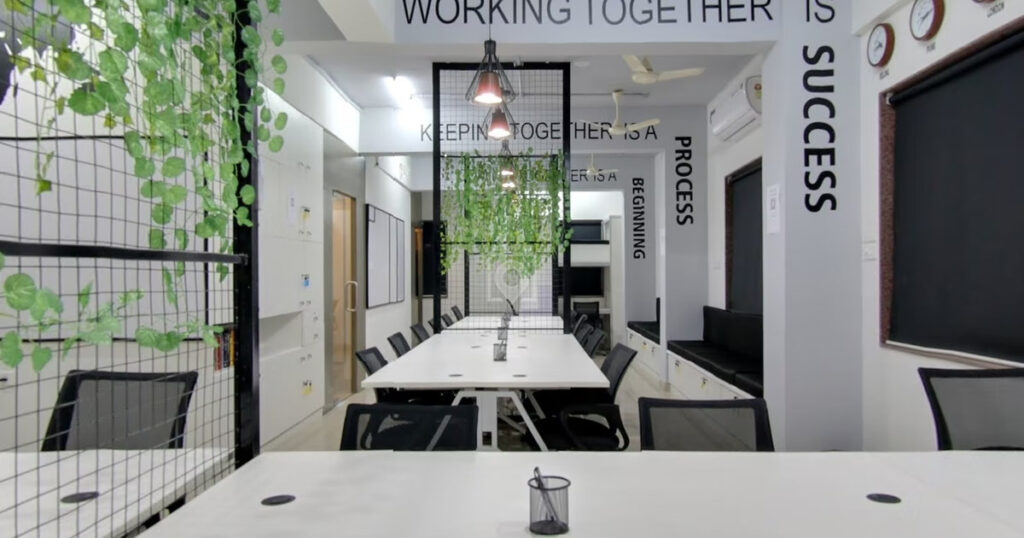The concept of co-working spaces is more pertinent than ever, given the current shifting dynamics of work brought on by the COVID-19 epidemic and an emerging hybrid working paradigm.
Companies are searching for novel ways to appeal to the younger workforce by fostering an environment at work that increases employee engagement and maintains a healthy work-life balance. This is more important than ever because of the past year’s radical shift in co-working spaces.
Advantages of co-working spaces
- Flexibility
- Productivity
- Greater Innovation
- Increased Networking
Flexibility
Although there is a misconception that flexible offices are only for startups and entrepreneurs, coworking spaces have repeatedly demonstrated that Indian businesses strongly prefer flexible workspaces. Large companies, MNCs, and corporations make up 60% of the overall member base at numerous coworking spaces, driving higher demand. Large businesses are increasingly choosing co-working spaces to draw in and keep the best young talent while fostering a unique cultural experience; large businesses are increasingly choosing co-working spaces.
Co-working spaces stand out because they are much more than just a flexible workspace; they are “designed for you,” whereas standard office spaces are more constrained in size and layout. It is a space-as-a-service platform that offers a more flexible and superior experience at a more affordable cost than other options while reducing the complexities of leasing real estate to a simplified membership model.
Additionally, co-working spaces are adaptable work environments, and a global presence gives businesses, particularly large ones, the opportunity to develop and enter new markets without sacrificing the employee experience.
Your workplace, your co-working space

It has been crucial to have enough room to accommodate business needs over the past year as social distance norms have grown necessary to return to the workforce.
The service covers a wide range of activities, such as assisting businesses in finding the ideal physical co-working space and negotiating lease agreements on their behalf. Moreover, custom office decor, construction, and design to suit specific needs, management of building operations, regular collection of back-end data on spatial efficiency, and co-working space management ensure the best experience for all occupants/members.
Some of the most prominent issues with office space rents for large businesses are the rigid contracts, which cause considerable pricing fluctuations with growth, high setup costs, and high overhead costs for maintaining the facility.
Companies collaborating with co-working spaces have a fixed membership premium that includes all advantages and considers annual increases based on property costs, operating costs, capital improvements, and management fees. Businesses benefit from the steadiness this offers and can use it to plan their annual budgets.
Businesses moving into large workspaces confront a variety of obstacles, including negotiating the best price and closing the sale, choosing the best furniture and design aspects, navigating hidden costs, and paying high setup costs, strong sanitization techniques, etc.
These elements result in several deals falling through or prolonged waiting periods. You can concentrate on framing strategies and innovative techniques to lead your organization while the co-working space takes care of everything else. It includes the agreement, sign-up, front-desk services, furniture, utilities, and events.
With the exception of flexible membership alternatives like short-term agreements, which ultimately minimize balance sheet liabilities, co-working spaces reduce move-in time by approximately a third compared to typical real estate options.
While overall productivity, employee effectiveness, and a happy work environment are significant drivers for workplace redesign in large firms, cost savings may not be the sole. Companies must provide co-working spaces that excite and motivate young workers and possibilities for collaboration and idea-sharing.
The new generation of workers enjoys working in exciting and flowing offices. The era of enclosed cabins and cubicles is over. According to global emerging trends in workplace design, millennials are willing to give up financial rewards to work in co-working spaces that have been creatively built and are in desirable locations.
The interiors at the co-working space are focused on utilizing architectural and design concepts to create an area that fosters employee innovation and productivity. Co-working space locations use a global playbook but with a local perspective that helps them provide design features to which members in each zone can relate, making them feel at home.
For major businesses and enterprises, a great degree of customization is available to have an office explicitly constructed to meet their needs and be compatible with their culture and workforce. The co-working space management is proactive in updating the building’s layout to conform to social distance rules and ensure thorough sanitization procedures following the outbreak.
The primary demand of most employees is a non-traditional work environment through offices that support an unconventional working style. They are looking for a setting that will foster their creativity and offer flexibility, a set that will accelerate their progress and provide the opportunity for networking and collaboration.
0 Comments